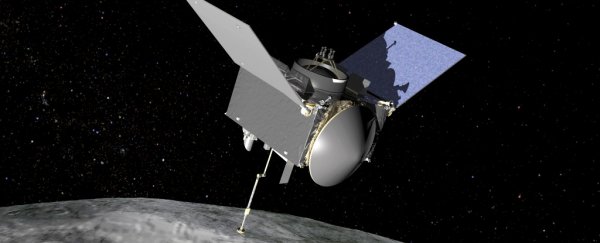Next month, NASA will launch a spacecraft with an important mission – to survey the Bennu asteroid, and bring back information about the early Solar System, possible organic matter, and the elemental building blocks of life.
But despite what you might have read online, this isn't an asteroid on a collision path to distroy Earth, and NASA isn't sending a probe there to try to figure out how to stop it smashing into us.
In fact, despite multiple headlines claiming that this is an "Armageddon asteroid", Bennu's likelihood of actually reaching - let alone destroying - Earth is next to none, according to the Torino scale, which is a scale NASA use to determine how much of a potential threat an asteroid is.
"On the Torino scale, Bennu is a zero. So the chance of it hitting Earth is very, very low," said Glen Nagel from NASA's tracking station in Canberra, Australia, in an interview with the ABC. "So you cannot rule it out completely, but on the current scale, zero."
The reason the media has been freaking out about Bennu it is that researchers have stated that it could potentially hit Earth some time in the 22nd century - but they've given it a 1 in 2,700 chance to do so. So let's not all panic about our children and grandchildren just yet.
And even if we were unlucky enough to get hit, we're certainly not looking at the total destruction of the human species.
"It would certainly cause devastation on large scale if it was to impact down," Nagel said. "It's about a half a kilometre in size. Certainly not the dinosaur killer that we tend to think of, or destroying the planet as they show in a lot of Hollywood movies."
The impact that killed the dinosaurs was thought to be closer to 10 km (6 miles) across.
"We're not talking about an asteroid that could destroy Earth," Lauretta told Space.com. "We're not anywhere near that kind of energy for an impact."
Okay, so now that's out of the way, let's get on with the science.
Although we've got a pretty good understanding of how many aspects of evolution work, we're still not 100 percent sure on how the organic compounds that created the conditions for the earliest life on Earth to form actually got here.
One of the most popular hypotheses right now is that asteroids collided with Earth and shared their organic compounds with us – leading to a world that could sustain life. And that's what NASA will be looking for signs of on Bennu.
Its OSIRIS-Rex (Origins, Spectral Interpretation, Resource Identification, Security-Regolith Explorer) spacecraft will be hitching a ride with the Atlas V 411 rocket in September this year, and will spend six years surveying Bennu.
"Did these kinds of bodies deliver organic material and water, in the form of hydrated minerals like clays, to the surface of our planet that created the habitability and the environments that may have led to the origin of life?" principal investigator for the OSIRIS-REx mission, Dante Lauretta, said in a press statement.
OSIRIS-REx departs Earth on September 8, and will orbit the Sun for about a year before making its way to Bennu, guided by Earth's gravitational field. The relatively small spacecraft will collect up to 2 kg of samples and head home for a 2023 landing.
We're looking forward to seeing what it can find…
